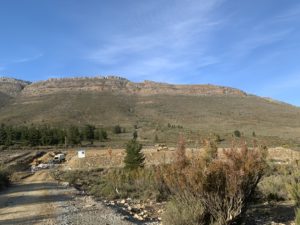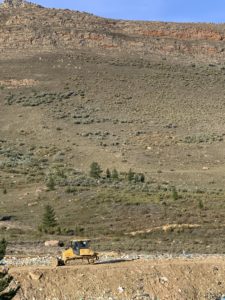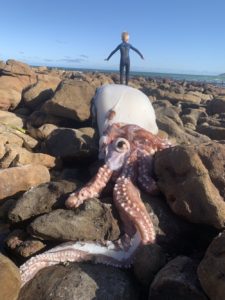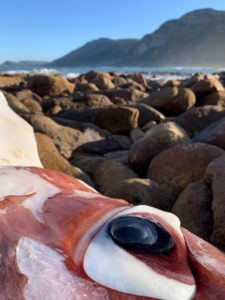Every year, we give over all of December (and usually most of January) to a series called ‘Shadows and Reflections’, in which our contributors share highs, lows and oddments from the past 12 months. Today it’s the turn of Tim Dee, who offers observations on the nature of dumps and of the dumped; reporting on two consecutive August days in the Western Cape with his wife, Claire, and their son, Adam.

Refuge of a vagrant marabou stork, the town dump at Op-die-Berg in the Western Cape of South Africa, August 2022
Day one. We stopped at a rubbish dump on our journey home from a weekend away. The fruit-farming town of Op-die-Berg gets rid of its unwanted stuff at its outskirts towards the edge of the Ceres Valley. The valley is named for its fruitfulness.
It was August. Back in March a marabou stork had turned up, of its own volition, on the Op-die-Berg dump. I wanted to see it. Marabous are ugly; this one had found refuge on a dump. Both these givens had probably prevented the vagrant from becoming a celebrity (there was little talk of it on the birding message boards); but a shitty bird forgotten on a shit heap was my sort of thing, fruitful for me. As voluntarily as the bird in question, I had been, for a fair while, an aficionado of junk birding, writing a book about gulls on rubbish dumps and, more recently, growing a feeling or affinity for the under-loved trash birds of my new home place.
We drove up a rutted track to a dead end. At the dump edge we got out of the car to watch the bird. It was immediately obvious. Like a sore thumb. Marabou is a French word, coming from the Arabic murābiṭ meaning ‘holy man’ – storks, as ibises, having more-than-bird status for many ancient peoples. It stuck out: a humanoid/hominin figure, tall, upright, suited, gaunt, a piebald monolith. At first sight, standing still and head on, it appeared to have risen from the trash which covered its feet, or sprouted from it, like a scarecrow-crucifix yet to raise its wings.
In the Western Cape the species is a rare vagrant; Claire had never seen one on her home-turf. They are known to wander nomadically but breed no nearer than northeast Namibia and north Botswana and with only a small population (300-400 birds) in the far east of South Africa in the Kruger Park. But it was an odd rarity. Having clocked it as soon as we arrived, we weren’t certain what else to do. I made sure Adam could see it without binoculars. That’s odd, he said, in his three-year-old being-helpful-to-the-grown-ups way. He knew marabous as one of The Ugly Five, Julia Donaldson’s generously anti-othering story-rhyme, where they are brilliantly depicted – on a dump, warts and all – by Axel Scheffler. A lifer for our boy, he didn’t say anything else. And that seemed in keeping with the stork. It is one of those birds that stops matters.
At the dump the marabou monster was given a wide berth. The other scavengers there, some doves, pied crows, white-necked ravens, and sacred ibises, must have feared for their own skins. A Gulliver among small things (a male marabou can reach 152 cm and weigh almost 9 kg), we watched it walking with a long and stiff old-soldier stride between the runnels and ridges of trash. It stopped and stood to a kind of insane attention while a bulldozer dozed past, pressure cooking the waste to bursting under its caterpillar tracks and pelicaning more splurging bags of filth into its wide silver mouth, a maw only a little larger than the great bone scoop of the marabou itself. The stork looked closer in life to the macerating machine than any other bird. But also, weirdly human too, like an elderly man, though one still strong, an old bruiser, a boxer perhaps: black and white garb topped with a bloodied-looking bald bonce and a wattled pouchy throat. There was also a strange circumspection about the bird, something stand-offish, almost clerical, in its giant upright awfulness, as if it knew that it is all those things, as if it was working out, or through, some sort of damnation or curse. In The Ugly Five redemption for the blighted African quintet (wildebeest, hyena, warthog, lappet-faced vulture, and marabou) comes only from the declaration of love from their offspring. On the dump, the marabou had a face that only a mother could love, as my own mother would say. The bristly hairs that alopecia-prickled its bare head like some sporing fungal mycelium, the leathery pink air-sac exposed like a goitre or wounded organ on its soup-dribbled white chest, the bill so heavy it gave its operator a hunch: I saw it as a kind of doorman, a gloomy attendent at one of the ways down to the underworld and its mucky Elysium, a broker of the in-between, a breaker of the dead, an undertaker.

The next day I was stopped once again at death’s door. Back in Scarborough there was a kraken on the rocks. A wrecked giant squid.
Around this time, just three, Adam had begun to take a keen though nervous interest in ghosts. They were in some of his favourite books and on several of his favourite videos, usually depicted as levitating white blobs, escaped billowy curtains with two dark eye holes. He was scared of them, he said, but wanted to look and often asked me to be a ghost and chase him, but not a real one. On Scarborough beach the giant squid came to me like a real ghost. Bulbous and white, some shape like a spooky blancmange, some partially set special jelly or rubbery gunk with a skirt of legs (so many I thought of Adam’s counting that – at that time – went 1, 2, 3, 4, 5, 6, 7-teen, 11, 14), and that, whatever it was, was certainly not from the place where it had come to rest.

Giant squid on Scarborough Beach, Cape Town, South Africa, August 2022.
The collapsed parachute of the epic alien was something like the prolapsed inside of a made-up animal, something exposed on Dr Frankenstein’s slab-lab or opened on the gutting deck of a deep-sea factory trawler. Hardly known to anyone on the land (first observed in its deep water home only a few years ago), the giant was unseeable even when looked at eye to eye. A voodoo jelly running mascara, some quark, some Caliban, a sad clown, invertebrate Dumpty, a phlegm ball, a gobbet gobbed up, disjecta of abyssal waters. If the marabou on the dump summoned one of the tramps (Vladimir or Estragon ) of Waiting for Godot, then the squid on the rocks was Lucky: there had been nothing from it forever (its hidden life in the depths) and then, all-at-once, there was this self-overwhelming deluge of itself, quaquaquaqua, a glut.
There was its size – more than four metres long – and the sameness or uniformity of its outer layers. It might have been a museum model of a hailstone enlarged for study. There were metres of the same unvarying white flesh mantle and metres of duplicated pink limbs. It was a plain giant. There was a lot but not much to it. It was itself magnified. I have never seen anything apparently so raw: its pink limb fringe, its white flesh mantle. Raw as in uncooked. All other life, it said, is somehow heated.
There was its eye. Far out of this world, putting it beyond all other seeing life. No other known animal, dead or alive, extinct or extant, has a larger eye. On the beach one only was on show, the sea had landed it that way. A great pooling wide-eyed eye in a dinner-plate sized saucer; a dark brown iris like a jungle bloom swimming in a super-white white; an eye deep and deeply sightless on the rocks though staring still and suggesting a last look impressed there, perhaps a first look in (and at) the open air, as it was trawled, by whatever it was that was killing it, from its happy depths to the deadly surface.

There was its beak. I’d heard before of the cephalopod’s beak but had never had one exposed to me. Its giant parrot mandibles, four centimetres across, making a mouth that was nested at the base of its provisioning limbs. If a giant squid took you in its suckered arms to eat, you would be passed that way and fed on into its oesophagus that runs through a doughnut hole around which curves its brain.
Some sharks perhaps had nibbled at the squid’s arms, several were stumps, but these injuries were likely the result of some posthumous scavenging not the cause of its death. There were no other visible wounds. I knelt to one of the squid’s snapped arms and ran a finger around its sucker cups. They held on even in death. Then I looked my last on its dead eye. You see how the world goes, looking like that, you see it feelingly, even if you can’t find the words. A kelp gull had landed near by hoping for a peck and there were white-necked ravens looking ravenous further up the beach. I walked back to the path at the top of the mortuary shore and continued home.
*
Tim Dee is working on a memoir of the last four years to be called ‘Home Scars’ which will combine his move to the Cape Peninsula of South Africa and the first years there of his son Adam, with two autumnal returns to England to sort out his old life, listening to his archive of radio recordings made for the BBC in three decades of work as a producer, and a month long odyssey through the West Country scattering the ashes of his late father who died in 2020…